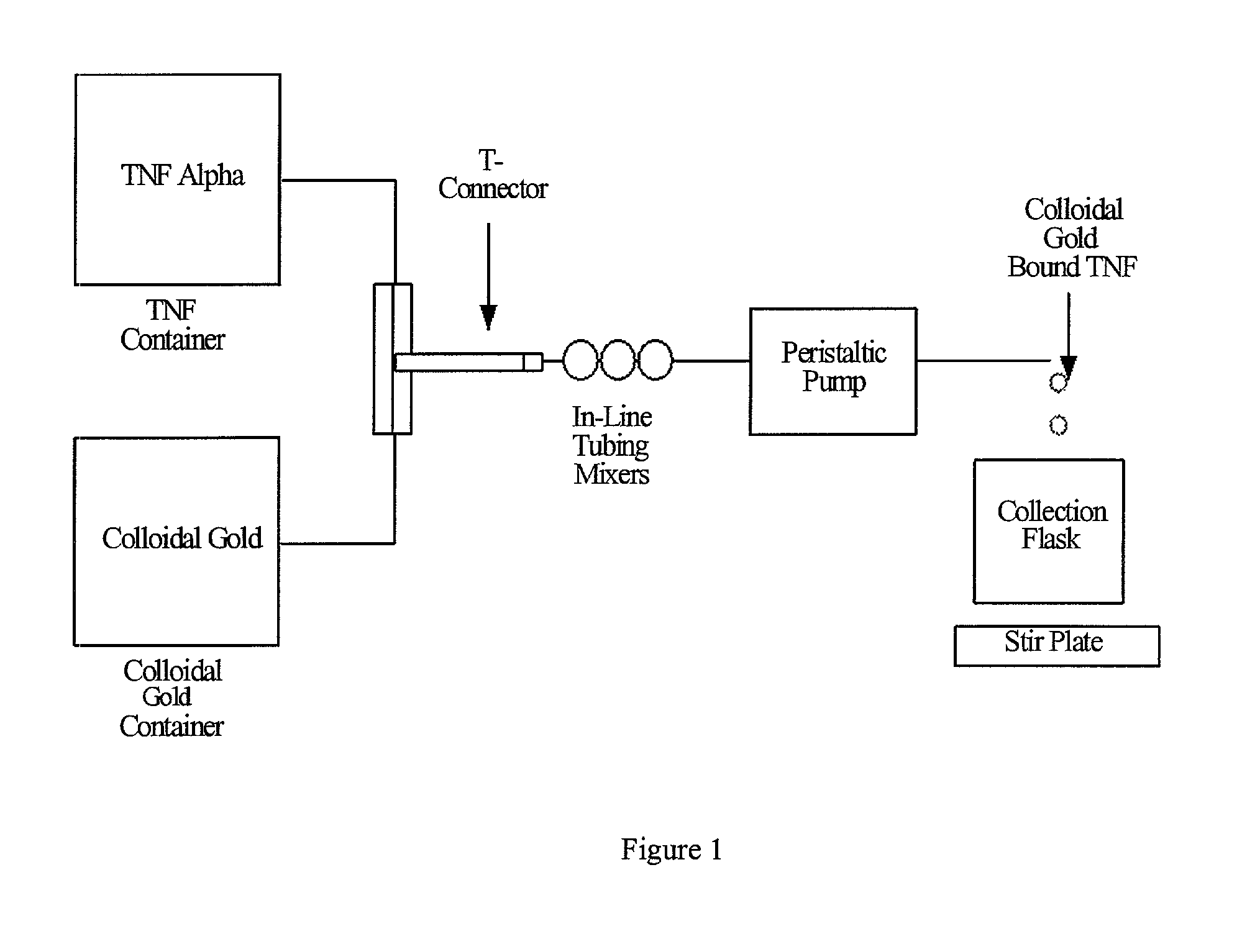Colloidal metal compositions and methods
a metal composition and colloidal technology, applied in the field of colloidal metal compositions, can solve the problems of low efficiency of exogenous genes entering cells, cell death, interference with the genetic control of cellular activities once bound to the target cell, etc., and achieve the effect of being particularly useful in detection
- Summary
- Abstract
- Description
- Claims
- Application Information
AI Technical Summary
Problems solved by technology
Method used
Image
Examples
example 1
Preparation of Colloidal Gold Sols
[0113]Colloidal gold is produced by the reduction of chloroauric acid (Au+3; HAuCl4), to neutral gold (Au0) by agents such as sodium citrate. The method described by Horisberger, (1979) was adapted to produce 34 nm colloidal gold particles. This method provided a simple and scalable procedure for the production of colloidal gold. Briefly, a 4% gold chloride solution (23.03% stock; dmc2, South Plainfield, N.J.) and a 1% sodium citrate solution (wt / wt; J.T. Baker Company; Paris, Ky.) were made in de-ionized H2O) (DIH2O). 3.75 ml of the gold chloride solution was added to 1.5 L of DIH2O. The solution was vigorously stirred and brought to a rolling boil under reflux. The formation of 34 nm colloidal gold particles was initiated by the addition of 60 ml of sodium citrate. The solution was continuously boiled and stirred during the entire process of particle formation and growth as described below.
[0114]The addition of sodium citrate to the gold chloride ...
example 2
Metal Sources
[0118]Experiments were performed to see if the source of the starting gold reactants for the formation of the colloid formation affected the colloidal gold compositions. Gold chloride was purchased from two different commercial sources: Degussa Metals Catalysts Cerdec (dmc2) and Sigma Chemical Company. Both gold preparations were analyzed for the presence of contaminating metals as well as other substances. The results from these studies are listed in Table II. Although the gold concentrations in each preparation were within reported values, it is clear that the Sigma preparation contains higher levels of Mg, Ca and Fe.
[0119]
TABLE IIPurity of gold chloride salts used to generate colloidal goldElementdmc2SigmaNa>21 ppmMg>60 ppmCa>60 ppmFe>60 ppm
[0120]TEM of the particles revealed further differences between the particles made with different gold chloride sources, from Sigma and from dmc2. The colloidal gold sols were manufactured as described above and observed used TEM....
example 3
Generation of Colloidal Gold Sols Using Sigma and dmc2 Gold Chloride
[0122]The above data suggested that the gold chloride from dmc2 contained lower levels of contaminating elements. To determine the effect of these two qualitatively different sources of gold chloride, colloidal gold sols were generated using the two different sources of the salt. The procedure for creating the colloidal gold particles follows the procedure originally described by Horisberger, and in Example 1. Briefly, a 4% gold chloride (in water) solution was made from the dmc2 and Sigma stock preparations. 3.75 ml of each solution was added to individual flasks each containing 1.5 L of water. The solution was brought to a rolling boil, kept boiling under reflux, and vigorously stirred. 22.5 ml of a 1% sodium citrate solution was added to each flask. The solutions in both flasks were kept boiling until the well-described process of colloidal gold formation was complete, signaled by a color conversion from gold to ...
PUM
| Property | Measurement | Unit |
|---|---|---|
| particle size | aaaaa | aaaaa |
| flow rate | aaaaa | aaaaa |
| concentrations | aaaaa | aaaaa |
Abstract
Description
Claims
Application Information
 Login to View More
Login to View More - R&D
- Intellectual Property
- Life Sciences
- Materials
- Tech Scout
- Unparalleled Data Quality
- Higher Quality Content
- 60% Fewer Hallucinations
Browse by: Latest US Patents, China's latest patents, Technical Efficacy Thesaurus, Application Domain, Technology Topic, Popular Technical Reports.
© 2025 PatSnap. All rights reserved.Legal|Privacy policy|Modern Slavery Act Transparency Statement|Sitemap|About US| Contact US: help@patsnap.com



